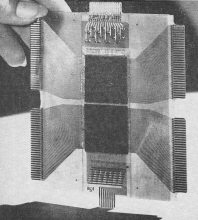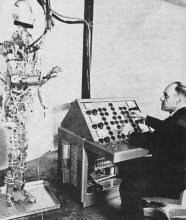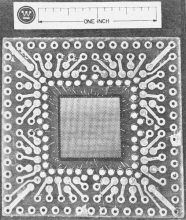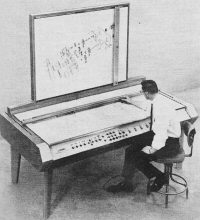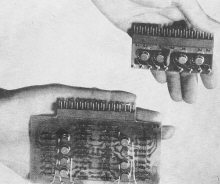Recent Developments in Electronics
|
|
The items reported in the September 1967 issue of Electronics World magazine represent the beginning stages of many technologies that are still in used today. The monolithic ferrite memory was a major producibility improvement in what was formally hand-wired toroidal matrices of cores. They were the first step in integrated memory (although we don't use magnets anymore in ICs (just on hard drives). The Electronically Controlled Robot looks like something from a modern Japanese university - without the skin, hair, and eyeballs. Note that as today, supplying power is one of the biggest hurdles in making a human-looking robot (umbilical required). The Solid State Camera "Tube" is one of the very first solid state camera imaging chips. It had a whopping 2,500 pixels. The Computer-Directed Drawing Machine converted a 2-dimensional drawing into a 3-dimensional perspective. Shipboard Satellite Communications was at the time one of the first uses of satellites for global communications, it being a big deal because active (powered) birds were only a few years into deployment. Recent Developments in Electronics A high-speed memory unit, potentially one of the simplest and most economical approaches to producing complex memory systems, has been made available to computer manufacturers by RCA. The memory wafer is constructed by embedding groups of perpendicular word and bit conductors between very thin sheets of ferrite material to form closed-loop ferrite "cores" with integral windings. This laminated structure is sintered using suitable ferrite firing techniques to produce a solid monolithic ferrite wafer with 64 word and 64 bit windings. This new process eliminates the tedious task of individual ferrite core stringing and hand-wiring, prime cost factors in conventional memory systems. Each wafer contains, in effect, 4096 cores with 5-mil diameter, not much larger than a hair. A new device that transforms the dots and dashes of Morse code into ordinary English is shown under field test by the Army. The translator allows those untrained in the code to read messages readily. The unit, built by Regency Electronics, is simply plugged into a radio set tuned to the station to be decoded. The letters are displayed by means of 17 tiny incandescent lamps in the panel of the cigarette-package-size device. Integrated circuits containing the equivalent of 350 diodes and 75 transistors are employed with 4 rechargeable nickel-cadmium batteries.
A six-foot-two 230-pound electronically controlled robot has been developed by IIT Research Institute for NASA as a mechanical model for space suits. Once fitted to a space suit, the dummy will give engineers exact measurements of the force it develops in order to overcome resistance to the occupant's movements offered by a pressurized space suit. The robot is shown without its aluminum-plate skin. The dummy is powered by hydraulic actuators at 35 joints, controlled by electrical servo valves directed from a remote panel. Sensors at each joint send back signals that indicate amount of force in each movement. A camera system that uses a solid-state imaging device instead of an electronic tube for light sensing and image conversion has been developed for NASA by Westinghouse. The imaging device is a mosaic made up of 2500 photo-transistors; it is 1/2-inch square with 50 light-sensitive semiconductor elements on a side. The image produced has a resolution of 100 lines per inch. The associated camera system uses integrated circuitry in order to perform the necessary functions to obtain video output.
The drawing machine shown here enables a draftsman to convert two-dimensional drawings into visually accurate perspective illustrations. Two styli on the horizontal plane trace blueprint views of the subject. Information is fed into the computer, which then guides an X-Y plotter pen on the vertical surface, creating a three-dimensional view. Tilt and rotation are determined by settings on a control panel on machine developed by Perspective, Inc.
A small, 6-foot antenna now being sea tested aboard the USS Canberra and USS Midway gives the Navy the capability for instant ship-to-ship and ship-to-shore communications through high-altitude "stationary" satellites. The shipboard satellite communications sets, built by Hughes Aircraft Co., provide both voice and teletypewriter communications unaffected by atmospheric conditions. The engineer shown would be dwarfed by "normal" paraboloid. The new integrated-circuit card, right, is one-fourth the size and does the same work as the old discrete component circuit board that it replaces in the new line of Systems Engineering Labs computers. The integrated circuits used are all silicon monolithic types. The new line of computers are general-purpose types designed for real-time processing and control operations or for scientific and general off-line computation. The silicon monolithic circuit elements used are supplied by Fairchild Semiconductor.
Posted August 16, 2022 |
|

